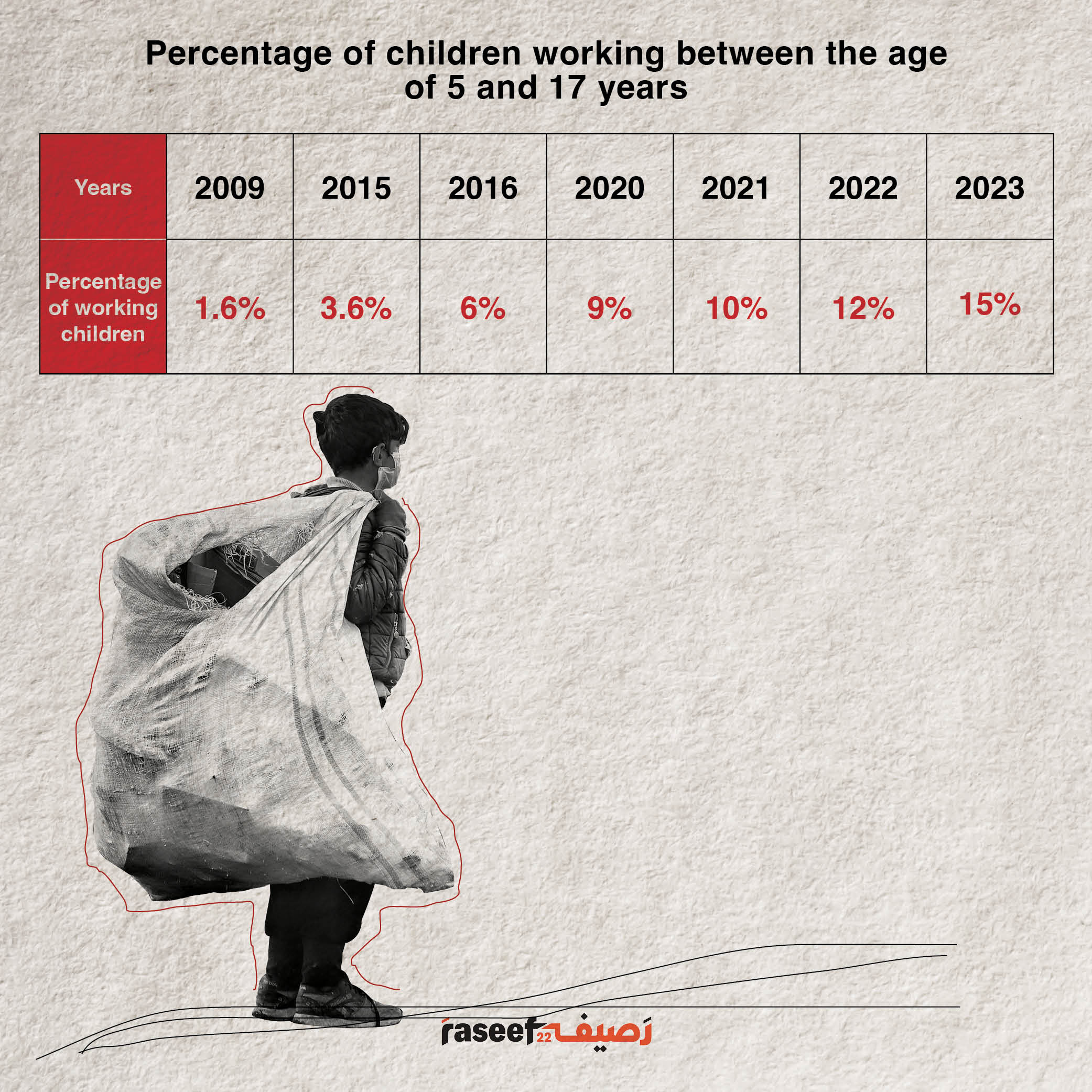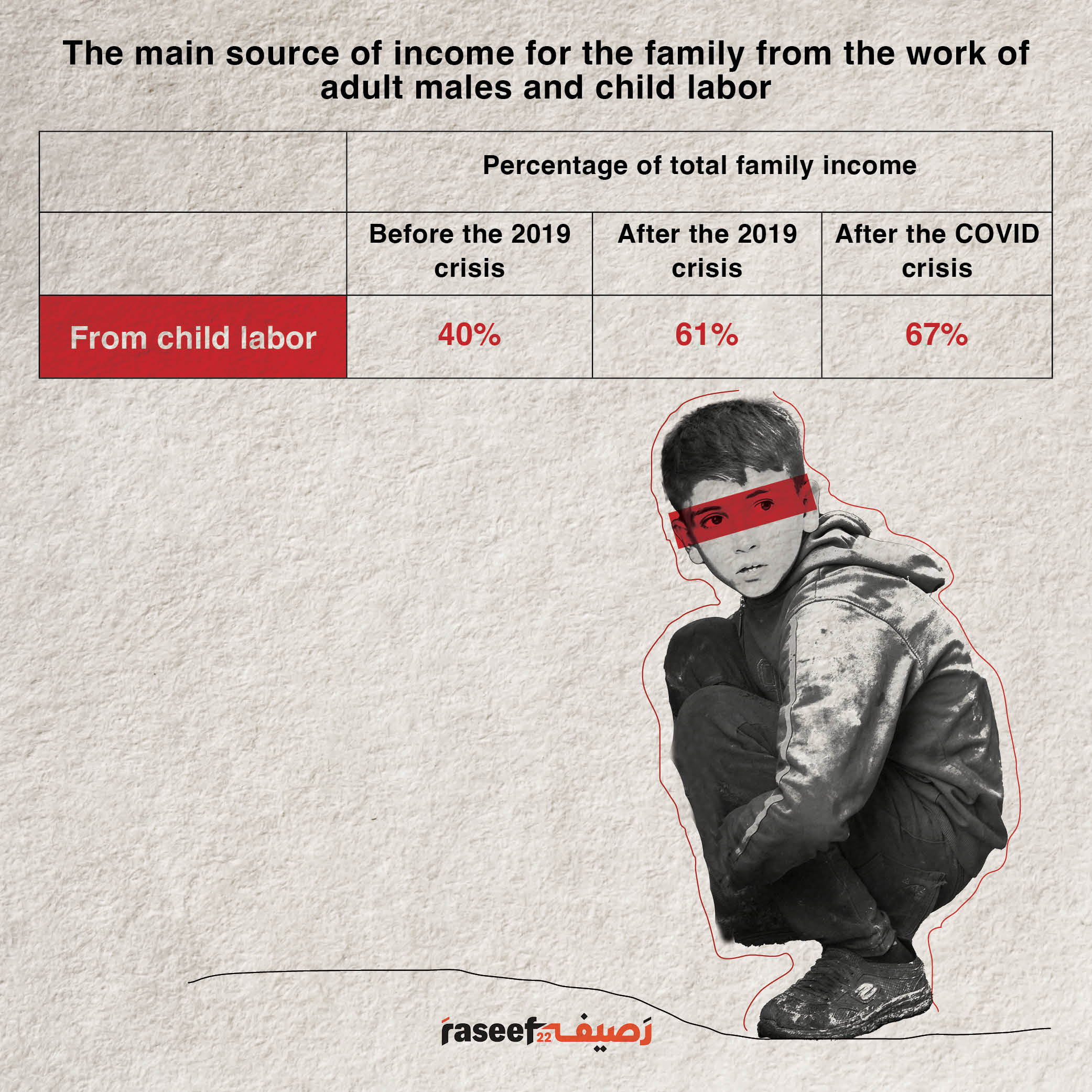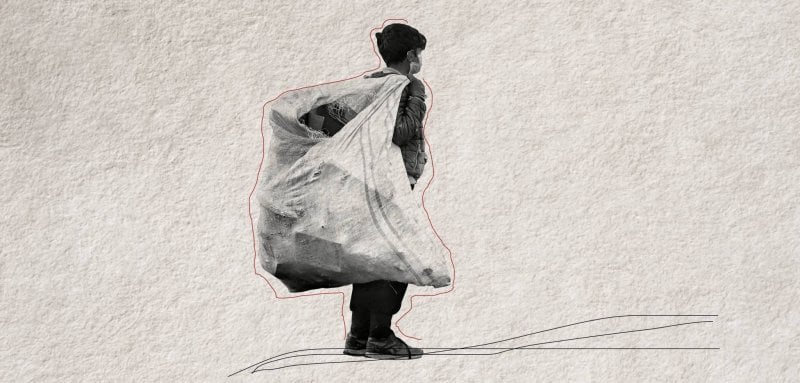A series of evaluations published over the last ten years indicate a continuous increase in child labor in Lebanon. In June 2023, UNICEF released a study revealing that nearly 15% of surveyed families in Lebanon had sent a child into the labor market, from the following sample: 52% Lebanese, 24.7% Syrian, and 23.3% Palestinian.
According to a study conducted by the Central Administration of Statistics and the International Labour Organization in 2015, out of 919,000 children in Lebanon, 33,474 children, constituting 3.6% of the total number, were working between the ages of 5 and 17.
Child labor rates are highest among 15-17 year olds, accounting for 8% of working children according to the Lebanese classification of child labor, and 6.7% according to the International Labour Organization. Additionally, 79% of working children engage in hazardous activities.
Despite the differing methodologies employed in these studies, they illustrate the temporal changes in child labor rates. The number of children in the workforce aged between 5-17 tripled between 2009 and 2016, increasing from 1.6% to 6%, even before the economic crisis in 2019.
 Data from various reports issued by UNICEF, the Central Administration of Statistics, and the International Labour Organization.
Data from various reports issued by UNICEF, the Central Administration of Statistics, and the International Labour Organization.
The table above indicates that child labor has continuously been on the rise since 2009. The economic crisis has led to increased child labor rates from 9% in 2020 to 15% in 2023, reflecting the ineffectiveness of authorities in reducing child labor. Notably, 79% of working children are involved in hazardous activities.
In other studies conducted before the current economic crisis by official and non-official entities, including the Lebanese Ministry of Labor, the estimated number of working children in Lebanon in 2016 exceeded 100,000 children. This figure included 62,000 Lebanese children, 37,000 Syrian children, and 4,500 Palestinian children. According to Nazha Shallita, head of the Child Labor Unit at the Ministry of Labor, these numbers increased by 20-30% after the economic crisis.
Of 919,000 children in Lebanon, 33,474 children work, constituting 3.6% of the total children aged 5-17. Child labor rates are highest among this age group, and account for 6.7% according to the International Labour Organization
Increased cases of child abuse
Lebanese labor laws stipulate that child labor should occur in a healthy and safe environment, free from threats to their lives and development. However, studies on child labor reveal the harsh conditions under which children in Lebanon work, as they face pressures, risks, and assaults without any effective regulatory oversight.
A 2019 study by the International Rescue Committee found that 52% of working children are exposed to physical risks. Additionally, 77.7% work in high temperatures, while 62.7% work in low temperatures. The study revealed that the likelihood of physical risks for those working in agriculture is 7.7 times higher compared to children in other sectors.
A total of 75% of working children suffered injuries due to the use of sharp tools and crop harvesting, especially in agriculture. Exposure to pesticides and other chemicals resulted in asthma (6.1%) and skin rashes (7.5%), while 33% of surveyed children experienced other consequences such as headaches, back and limb pain, broken limbs, chipped or broken teeth, colds, flu, and burns.
The report indicates that the number of child abuse cases and those addressed by UNICEF and its partners increased by 44% between October 2020 and October 2021, from 3,913 cases to 5,621 cases.
In a survey conducted in 2019, many child laborers reported working for up to 15 hours per day, with only a day or half-day off per week. The study revealed that working girls face worse conditions than boys, with 66% (55.2% of which are males) of all working children stating that they worked in psychologically and socially hazardous conditions, while the percentage for working girls increased to 76.8%. Moreover, 38% (34.1% of which are males) of all working children reported experiencing at least one violent incident at work or on their way to work, while the percentage among working girls reached 41.9%.
The majority of working children suffer physical and verbal abuse at work. 58.3% of cases involve physical abuse, while verbal abuse accounted for 28% of recorded cases.
The majority of working children, at 74.4%, reported suffering physical and verbal abuse at work. 58.3% of cases involved physical abuse, while verbal abuse accounted for 28% of recorded cases.
Most cases of physical abuse manifested as extreme conditions in the workplace, with 29% of children surveyed reported the use of sticks or hoses as tools for beating. Girls were more likely to report psychological and social infringements than boys. Numerous cases of sexual abuse and harrassment were reported by working girls and boys.
Child labor and providing food for the family
The 2022 report ‘Working children in crisis-hit Lebanon: Exploring the linkage between food insecurity and child labor’ indicates a rise in children working to contribute to the family’s income, from 40% before the 2019 economic crisis, 61% after the crisis, to 67% in 2022.
According to the report, the primary and direct cause of child labor in Lebanon, particularly among Syrian children and in impoverished areas of the country, is the inability of the heads of the families to support and provide their family's nutritional needs.

This raises the question: Does child labor ensure food security for their families? The answer is no. The wages received by working children are unjust and insufficient in improving their family's financial situation and lifting it out of poverty. Instead, the results of child labor and the adverse conditions these children work in, which often negatively impact their health, eventually deplete any earnings. The main contribution of child labor lies in alleviating poverty, especially as studies on child labor have not provided sufficient data on the wages of working children. However, it is evident that the wages of working children do not cover their basic needs.
Lebanese labor law and child labor
The Lebanese labor law categorizes children into two main groups: those under 14 years old and those between 14-18 years old. The law outright prohibits employing children under 13 years old, and it prohibits employing any child under the age of 16 in certain types of work deemed harmful. The law stipulates that no child should work for more than six hours a day, and at least one hour of rest should be provided whenever the total working hours exceed four hours in a day.
In 2000, the Lebanese government officially declared its commitment to ending child labor. In line with this commitment, it launched a program in collaboration with UNICEF and the International Labour Organization to combat child labor. In 2012, Decree No. 8987 was issued, explicitly prohibiting the employment of children in hazardous work, especially in situations where physical and mental health are at risk. The age for applying these restrictions was lowered from 18 to 16 years old. The decree also prohibits minors from working in agricultural activities that involve operating agricultural machinery, handling pesticides or fertilizers, dealing with poisonous or toxic plants, or working for more than four hours a day. Despite these measures, child labor remains prevalent within the agriculture industry, where children younger than the age of ten often begin employment.
Despite official recognition of the extent of child labor in Lebanon and the government's adoption of a series of measures since 2000, the number of child laborers hasn't declined; rather, it has risen, along with worsening working conditions and increased exploitation
The inadequacy in addressing the issue of child labor
Combating the phenomenon of child labor cannot be resolved by assigning responsibility to a specific legal entity. Instead, it requires a set of integrated interventions as part of comprehensive economic and social policies, reflecting the productive relations in society and its level of development.
Despite official recognition of the extent of child labor in Lebanon and the government's adoption of a series of decisions and measures since 2000, the number of child laborers has not declined; rather, it has risen, along with worsening working conditions and increased exploitation. The role of the government, international organizations and NGOs at efficiently combating child labor comes into question.
Institutions involved in addressing child labor often attribute their ineffectiveness to administrative and financial factors. Some of the reasons that were identified and monitored from interviews and reports published in the media include:
A shortage of inspectors in the Inspection Department at the Ministry of Labor, with only 11 technical inspectors and fewer than 20 administrative inspectors with assistants. They are unable to cover all sectors and regions in Lebanon.
A lack of the necessary funding to implement the plan launched by the National Committee for the Elimination of the Worst Forms of Child Labor. The absence of funding is not only related to the Ministry of Labor but also to other relevant ministries, such as the Ministry of Social Affairs, the Ministry of Justice, and the security forces.
The closure of centers established by the Ministry of Labor in Beqaa, Tripoli, Nabatieh, and Ouzai due to the suspension of funding from donors, civil society associations, and charitable institutions.
However, is the problem solely related to financial and human resources, or is it rooted elsewhere?
Since 2019, the National Committee to Combat Child Labor has not convened because “previous ministers did not prioritize the issue” according to Nazha Shallita, head of the unit combating child labor at the Ministry of Labor.
Examining the work of international institutions indicates that they organize workshops and bring in international "experts" to provide "advice" without tangible results and actual accomplishments on the ground that directly impact the elimination of child labor
The latest report published by the Ministry of Labor on achievements in 2018 in combating child labor states that “it facilitated communication between the International Labour Organization, and the relevant ministries, municipalities, and the Union of Municipalities. Additionally, it supervised the preparations for the launch of a choir named 'Anti-Child Labor Choir' on the occasion of the celebration of Children's Day at the Presidential Palace on March 20, 2018,” as part of the Music Against Child Labor initiative launched by the International Labour Organization in 2013 with world-renowned musicians.
The ministry, through officials responsible for the unit combating child labor, justifies that “the fundamental gap is the lack of a budget to combat child labor, alongside the absence of funding from donors and international organizations... The International Labour Organization, directly involved in the file and responsible for material and technical support, is content with merely issuing reports.”
Examining the work of international institutions reveals the density of their reports on topics within their mandates and the reasons for their existence. They organize workshops and bring in international "experts" to provide "advice" without tangible results and actual accomplishments on the ground that directly impact the elimination of child labor.
Data from all studies addressing child labor show that poverty and food insecurity go hand in hand. Child labor is merely a natural product of the exploitation inherent in dominant production relations. Interventions led by international organizations and non-governmental associations linking child labor to the lack of food security in their families, represented by increasing cash assistance (Cash for Work), do not address the real causes of child labor. Therefore, they fail to provide a root solution to the problem, keeping their interventions within the framework of "humanitarian relief" by distributing cash aid or organizing "folklore-like activities" with workshops, meetings, and studies that have not led to combating this deeply-entrenched phenomenon. Meanwhile, the numbers of children engaged in the labor market increase, their working conditions become harsher, and poverty is reproduced.
Raseef22 is a not for profit entity. Our focus is on quality journalism. Every contribution to the NasRaseef membership goes directly towards journalism production. We stand independent, not accepting corporate sponsorships, sponsored content or political funding.
Support our mission to keep Raseef22 available to all readers by clicking here!
Interested in writing with us? Check our pitch process here!








